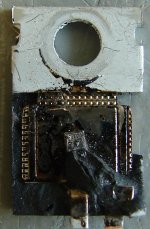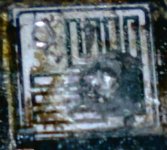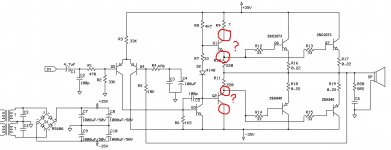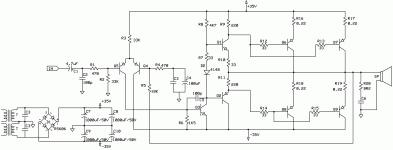For £70 that is a cheap 2U, transformer and heatsink. Could put a nice 40W per channel amp in it, although 120VA might be a bit small.
D2 is mostly a three diode assy? and s/b mounted to the output heatsink as well the drivers. If it isn't , then you need to keep the heat rise down, by low bias current and a big HS or Fan.I just noticed the value of R7 - 33ohms - this is a pure class B design!
Svokke : If you want good sound you should skip the original pcb, and put in another amplifier.
Last edited:
I am very interested in this schematic. The amplifier I have looks exactly the same as a skytec PA-240, only difference is the name tag in the center of my front panel ("IBIZA"). This way we would finally know what are the output devices.almost the same amp design can be found in those "hollywood" or "skytec" or "nightline" or whatever amps you can get off ebay here in germany. they are also rated 480 watts (although there is an even cheaper model rated 240 watts, which has only two output transistors per channel)... i have the schematic diagram of these amps somewhere, perhaps i'll find it, so i can upload it here.
Can we see the front face of the amp please? It looks very much like my Skytronic amp. Except mine's rated at 600W and weighs quite a bit.
D2 is mostly a three diode assy? and s/b mounted to the output heatsink as well the drivers. If it isn't , then you need to keep the heat rise down, by low bias current and a big HS or Fan.
I tend to use low bias on my amps so I dont need any thermal feedback.
I apply a sine wave and monitor the output across the speaker.
I turn up the bias until crossover distortion just goes.
Usually sounds pretty good.
following up on Jaycee's advice.
The easiest way to save most of your investment is to throw away the amplifier PCB and substitute one or two chipamps.
With the 26Vac transformer a 3886 can put out a maximum of ~60W into 8r0.
You could not use it for 6ohm or 4ohm speakers.
The easiest way to save most of your investment is to throw away the amplifier PCB and substitute one or two chipamps.
With the 26Vac transformer a 3886 can put out a maximum of ~60W into 8r0.
You could not use it for 6ohm or 4ohm speakers.
following up on Jaycee's advice.
The easiest way to save most of your investment is to throw away the amplifier PCB and substitute one or two chipamps.
With the 26Vac transformer a 3886 can put out a maximum of ~60W into 8r0.
You could not use it for 6ohm or 4ohm speakers.
Or a nice Tripath amp.
In fact with a tube pre-amp PCB and a tripath main amp PCB it could be really nice. Most other things will be more expensive and poorer sounding.
Today I took one of the transistors apart. I think this looks like a bipolar. So it really could be the 2SA940 or KSA940, both PNP devices. Is this die about the correct shape and size for those transistors?
Can you measure the junctions still? It looks like just the bond wires have been blown away..
The transistors measure completely open or short circuit between the pins. Not a single transistor measures like a PN-junction.
Edit:Maybe I interpreted your post wrong. Tomorrow I will try to measure directly on the junctions.
Edit:Maybe I interpreted your post wrong. Tomorrow I will try to measure directly on the junctions.
Last edited:
The most left pin of Q6 goes to the middle pin of Q1(=collector) in your picture. I have re-drawn the schematic.
In that case it is safe to say that all four transistors must be PNP.
Replace with four new ones and your amp should be as good ( ..or as bad 😀) as before.
Today I took one of the transistors apart. I think this looks like a bipolar. So it really could be the 2SA940 or KSA940, both PNP devices. Is this die about the correct shape and size for those transistors?
The A940 is a freaking driver transistor. It's not supposed to be any bigger. TIP 42 (or 2955) would be an improvement, as would MJE1503x or the D45 types.
But TO220s on a small heat sink - don't expect miracles.
"allowing for loss in the resistors and mosfets you'd probably get 70wpc from it."
At 4Ω?
Maybe if going downhill, with the wind behind your back.
At 4Ω?
Maybe if going downhill, with the wind behind your back.
- Status
- Not open for further replies.
- Home
- Live Sound
- PA Systems
- Inside a "no brand" PA Amp...




